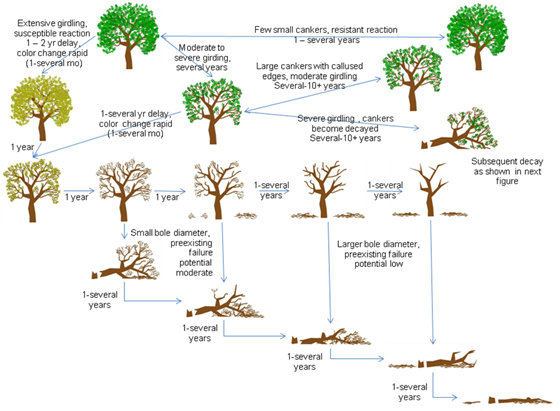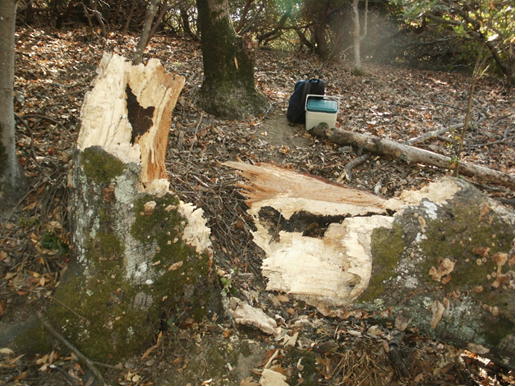
As long as noninfected P. ramorum canker hosts remain on a site, the disease prevention activities of the During phase (table 2-3) may still be appropriate. However, once a high proportion of canker hosts have died, management emphasis shifts toward dealing with the aftermath of SOD. This section discusses three main management issues:
Removing SOD-infected oaks has no effect on disease spread in the stand, since the pathogen does not sporulate on oaks, they are a “dead end” for the disease. Hence, determining whether or when to remove SOD infected oaks should be based on management criteria such as potential hazard, cost, and wildlife habitat value.
Trees with P. ramorum canker can follow a wide range of survival trajectories over time (see 1.4.2 Patterns of Disease Progression and 1.4.3 Survival of SOD-Affected Trees). This variation in possible fates can make it more difficult to decide if and when to remove symptomatic trees. Factors correlated with survival are summarized in table 3-3.
Oaks and tanoaks with late symptoms of P. ramorum canker have an increased risk of failure (breakage) when compared to healthy, noninfected trees (table 2-6). Because SOD cankers typically affect the lower trunk, decay associated with SOD cankers often leads to trunk failure. SOD-infected trees often die as the result of large scaffold or trunk failures before the SOD canker actually causes death of the top (fig. 1-15).
Trees with P. ramorum canker have an increased risk of failure due to two main factors:
All dead trees, and dead parts of live trees, have an elevated likelihood of failure whether or not SOD was the cause (table 2-6). Pre-existing wood decay hastens failure of SOD-killed trees.
Table 2-6—Average annual failure rates (percent of trees in disease category that failed each year) by disease category in 630 coast live oaks observed during a ten year period in SOD-affected forests in Marin and Napa Counties
|
Disease category |
Average annual failure rate |
Dead due to SOD |
42% |
Dead due to other causes |
20% |
Late SOD symptoms (beetles and/or Annulohypoxylon thouarsianum present) |
11% |
Early SOD (bleeding cankers only) |
0.4% |
Healthy, not SOD infected |
0.4% |
In SOD-killed trees, small diameter branches and trunks typically decay fairly rapidly and often become heavily colonized by wood-boring insects. If trunk failure does not occur first, branches and scaffolds of SOD-killed trees commonly begin to fail within one to two years after death (fig. 2-2A). Remove dead trees or branches located where they may pose a significant risk to people or property as soon as possible.
Many oaks and tanoaks with P. ramorum trunk cankers develop an extensive white rot of the sapwood caused by the decay fungus A. thouarsianum. Cankered areas and killed portions of the canopy are typically affected first. Other decay fungi, including Phellinus gilvus, may also be present and cause similar decay. In small-diameter trees (less than about 30 cm), sapwood decay associated with these secondary decay fungi can be extensive enough to cause trunk failure (fig. 2-2A). Such failures typically occur within one to several years after the top has died.
In larger trees, trunk failure commonly results from a combination of SOD-related sapwood decay and pre-existing heartwood decay (fig. 2-3). Many large oaks have extensive internal decay associated with canker rot fungi (especially Inonotus andersonii, I. dryophilus, and Phellinus robustus) or other aggressive wood decay fungi such as Laetiporus gilbertsonii. In these trees, even small amounts of sapwood decay by A. thouarsianum and P. gilvus may trigger failures when the sapwood decay extends to areas affected by heartwood decay (fig. 2-3). This process is often involved in failures of live trees (fig. 2-2B). In contrast, large-diameter oaks that are killed by SOD but lack pre-existing heartwood decay may stand for 5-10 years or more before trunk failure occurs (fig. 2-2A).
If trees infected with SOD are located where the failed stems may impact persons or property, periodic monitoring is needed to identify and mitigate potential hazards well before failure is imminent. Hazards may be reduced by pruning or removing trees or by keeping people and property outside of the potential impact area (i.e., removing the target). In areas with many potentially hazardous trees, permanent or temporary closures and posting may be used to reduce the chance that target areas will be occupied when tree failures occur. Trees that have not been affected by SOD can also have a high risk of failure due to decay and/or structural problems (fig. 2-4), so hazard assessments need to consider all potentially hazardous trees, not only those with SOD.
In areas with many trees affected by SOD, it may be necessary to prioritize and phase removals. Trees that are likely to impact persons, structures, utility lines, or access roads are typically the highest priorities for removal or mitigation. Trees that are most likely to fail before the next inspection period should be targeted as the highest priorities. The criteria in tables 3-2 and 3-3 (Part 3) can be used to help identify trees that are more likely to die or fail in the near term.

Figure 2-2A—Paths of SOD disease progress and eventual tree degradation in coast live oaks that have little or no preexisting wood decay in the trunk. Such trees typically do not fail before the top is killed, and snags may stand for a number of years before the trunk fails. Tree at upper left represents a newly infected coast live oak with only bleeding cankers.
Figure 2-2B—Paths of SOD disease progress and eventual tree degradation in coast live oaks that fail while the top is still live (green failure) or within a short time after rapid death of the canopy. Trees following this pattern typically have large amounts of pre-existing wood decay in the trunk, other severe structural defects, and are extensively colonized by secondary decay fungi and beetles. Tree at upper left represents a newly infected tree with bleeding cankers only.

Figure 2-3—Failure of a large Phytophthora ramorum killed coast live oak associated with pre-existing heartwood decay and cavity in the center of the trunk. Fruiting bodies of Annulohypoxylon thouarsianum and Phellinus gilvus on the stem are associated with sapwood decay that developed after P. ramorum infection.

Figure 2-4—The trunk of this coast live oak failed due to extensive internal decay. Although the tree was in a location where SOD is common, this tree was not infected with Phytophthora ramorum.